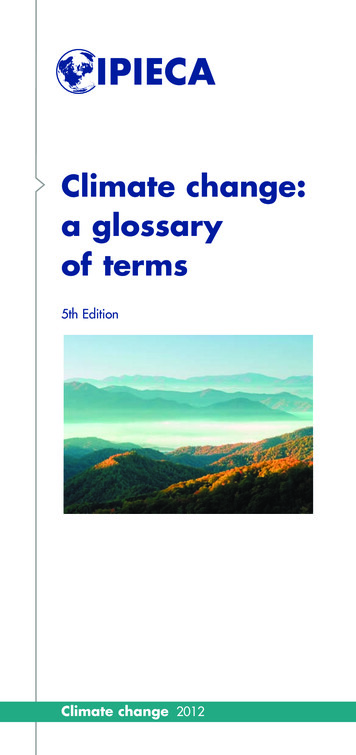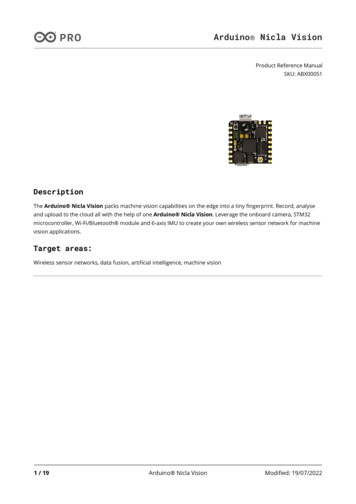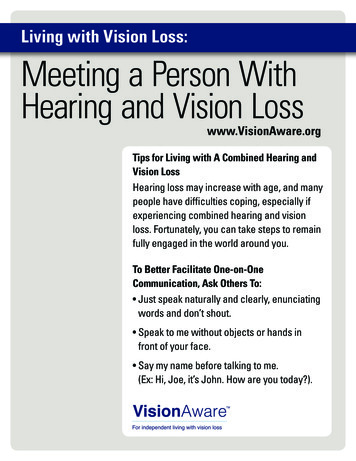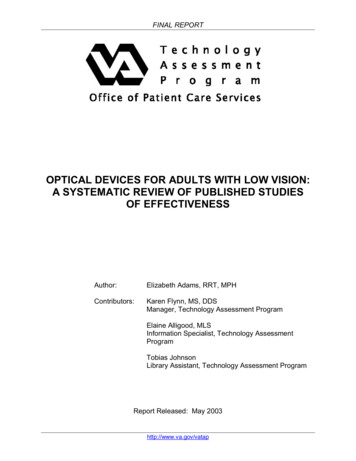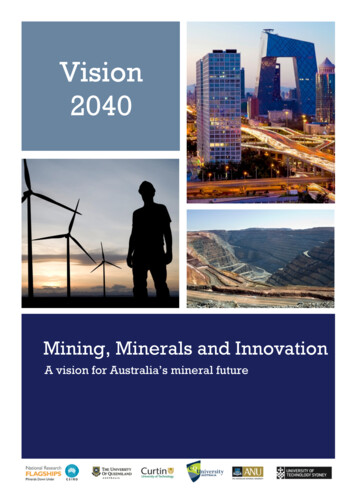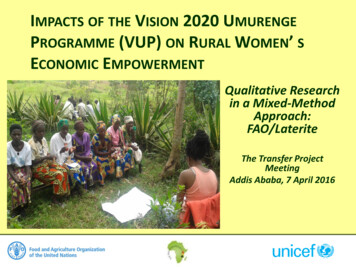
Transcription
IMPACTS OF THE VISION 2020 UMURENGEPROGRAMME (VUP) ON RURAL WOMEN’ SECONOMIC EMPOWERMENTQualitative Researchin a Mixed-MethodApproach:FAO/LateriteThe Transfer ProjectMeetingAddis Ababa, 7 April 2016
PRESENTATION Background Qualitativeresearch approach-HypothesesSamplingRoadmap VUP highlights Findings Recommendations
BACKGROUND FAO Protection to Production(PtoP) & Transfer Project FAO – SCT linkages toagriculture; ruralinvestments; improveresilience & livelihoods FAO RWEE agenda:-strengthen access of SPbenefits for women & HHs-identify good practice ingender-equality in SPdesign/implementationto strengthen access &impacts Bringing useful evidence,messages, recommendationsto policymakers
QUALITATIVE STUDY HYPOTHESES 1. Economic advancement: SP programmes that promoteeconomic advancement of women increase theirproductive resources (e.g. incomes, access to credit) &also can improve their skills & employment opportunities.2. Power and agency: SP strengthens women’s power &agency by increasing their bargaining power within thehousehold & wider community. This increases selfconfidence, ability to engage in social networks &participation in public decision-making.3. Operations: When SP design & operational featuresensure women’s equal access to benefits & build linkageswith community-based services & livelihood interventionsthey promote gender equality & women’s economicempowerment.
WHAT DOES THAT MEAN FOR VUP? THEORY OF CHANGE .VUP can advance women’s economic advancement through: Promoting access to cash Increasing participation in (decent) wage employment Enabling savings and investment Skills development Minimising detrimental coping strategiesVUP can advance women’s power & agency through: Individual ownership of cash/assets & own decision-making on howthey are used Increasing bargaining power, voice at HH & community-levelProgram Operations can support these outcomes through: Good performance in implementation - this supports empowermentoutcomes Gender-sensitive design (e.g. female quotas, address gender-relatedconstraints to participate)
VUP – A FEW HIGHLIGHTS Launched 2008 - managed by LODA (MINALOC) - implemented withdecentralised gvt. & other ministries 3 prongs:-DS: up to US 21 /5pHH/monthly for labour-constrained HHs (20% of VUP resources)-PW: wage US 1.42/d) (set at local market wage rate) – paid every 15days in bank account(SACCO); cosignatories encrgd; can rotate work; works selected from sector plans actualdelays in payment up to year– coverage March 2015:130,000HH in 172 of 416 sectors(50%of VUP resources)-FS: low-interest loans to anyone (for NONBENs, must be in groups including BEN members)(30% of VUP resources) sensitization and training in all above Targeting community-based – following ubudehe – 1 2 levels eligible– target HH (head of HH registered as BEN) - rescreen annually PW gender parity goal - 50% BENs should be women (unclear if ‘asregistered BENs’ or ‘as workers’ actual, much higher (majority) no.workers are women & @30% FHH BENs PW target – min. 71 days/yr. (@4 phases/15d each over 3 mo.) –actual @50d/yr. - our data Ndego: 15d/yr. only VUP in revision – piloting new ‘ graduation package’ & strengtheningfor timely payments, days worked, sensitization, linkages
METHODOLOGY: SAMPLING, APPROACH, ROADMAP systematic sampling protocol – in each province: 1 district, 1sector, 2 cells (near/far), 1 village in each cell training of local research team (4 days 1 pilot day) 2 weeks fieldwork: 1 week each province 4 days village 1 day comparison community nightly debriefings and end-of-week syntheses village/district/national feedback: validation and ownership “Roadmap” – systematic FGDs with BENs and NONBENs usingparticipatory tools; KIIs; in-depth HH case studies; snowballinginterviews- 34 FGDs; 19 KIIs; 2 case studies; other resource personsResearch guide on PtoP website: http://www.fao.org/3/a-i4420e.pdf
RESEARCH LOCATIONS: KAYONZA & GISAGARA
FINDINGS
HYP 1 – ECONOMIC ADVANCEMENT & TIME USE Women ‘earning’ cash thru PW, but seldom able to retain full or evenpartial control VUP payments thru SACCOs allowing some women to own a financialaccount for the first time - & providing possibility (for a minority) toaccess loans Women’s own SACCO accounts (when existing) facilitates decisionmaking & control over credit & their income– but earnings are small Women’s lower literacy skills and unequal bargaining power within thehousehold are key constraints to accessing loans VSLs & other informal lending (e.g. tontines) are main credit sourcesfor women – VUP has enabled some women to join these for the firsttime & access loans A requisite for married individuals applying for a loan from SACCO isspouse consent; some women expressed fear on misuse of loans byhusbands For a minority of female BENS, wages from PW serve as a catalyst forsmall investments (petty trade, brewing beer, renting land) – but mostwages used for consumption smoothing
HYPOTHESIS 1 – CONT. Despite women being the majority of workers, no changes foundin time allocation for domestic activities (e.g. care) - men report50 -75% more leisure time than women VUP participation increases workload of women & children(women offloading some domestic burden) Inability to hire in labor (agriculture or care activities) to make upfor less time available BENs do learn new skills (e.g. levelling roads, digging ditches,constructing terraces) – but this is mostly ‘on the job’ - womennot able to find similar jobs elsewhere due to domesticobligations & few viable opportunities Migration (for men & women) continues as a common copingstrategy during drought/difficulties - low number of work daysand unreliable payments limit improving coping But, some indication that VUP helps improve resilience throughinvestments (e.g. livestock as precautionary savings)
HYPOTHESIS 2: WOMEN’S POWER & AGENCY
HYP 2: POWER & AGENCY VUP is contributing to ongoing positive enabling environmentfor women’s empowerment - positive perception & views onwomen’s economic role & capacity to engage in incomegenerating activities But, momentum concerns activities of small amounts of cash(e.g. day-to-day household expenses), issues of less priority Relatively small cash wage amounts & implementationchallenges key reasons for VUP shortcomings in promotingmore change in women’s power & agency at household level Men have greater asset ownership than women, yet women &men bear similar responsibilities, particularly in agriculture Women reported as continuing to have limited ability tonegotiate, voice their opinions & assert their rights inhousehold
Hyp 2HYPOTHESIS 2: CONT The use of VUP cash for personal and children’s items and economic investmentsresulting in heightened feelings of self-esteem, dignity, increased ability to makeindependent choicesBusasamana: “Now that I have a SACCO account I have some small money that myhusband is not aware of so if I want to buy something for the children I can do itwithout having to ask him.” For some, VUP is catalysing social capital - inclusion in social networks foreconomic collaboration & mutual support (e.g. mothers’ evenings, VSL) withpositive spill-over feelings of self-confidence Women are forming new friendships, exchanging information, fostering a senseof unity & support – often at worksite But this does not result in increased leadership or decision-making in the publicarena: mixed findings about speaking up in public, some feel enhancedconfidence & self-worth, most feel shy & embarrassedA woman from Taba: “before I was afraid to go to community meetings including“mothers’ evenings” because I had dirty clothes, but now I am clean, I feel betterto attend and sometimes I speak up.”
HYPOTHESIS 3: OPERATIONAL ISSUES/RWEE
Hyp 2HYP 3: OPERATIONAL ISSUES Targeting may be risking exclusion of the poorest: In practice - not fully aligned with targeting criteria - inclusion errors from ubudehecategory 3 obstacles for some households to attend targeting meetings (e.g. households withhigh dependency ratios/FHHs) VUP not attractive for the poorest : short-term status, few days, delays in payments,low pay VUP workers tend to be females - males find work unattractive and migrate elsewhere Limited number of work days available compromise the potential for improving women’sand men’s economic empowermentKigembe: “VUP is for people who can afford to wait for payment.” Average work sites far from beneficiaries’ dwellings: between 2.5-3 hours Distance & work tasks problematic for female-only households with low labor capacity Delays in payment continuous (quant. survey data from Southern show 32 percent oftotal payment not been paid at time of data collection) Absence of multi-year monitoring system to track BENs : Cumulative number of days worked in different projectsPhases in which individuals have worked and yearsIdentification of household members that worked
Hyp 3:HYPOTHESIS 3: CONT. A majority of BENS had not been reached with sensitizationmessages – inconsistent delivery Little training and skills development (e.g. financial literacy) General lack of awareness among beneficiaries of how VUP projectsare selected & lack of understanding of the linkage with localdevelopment (imihingo) process Limited gender sensitivity for addressing specific challenges, needs& priorities of female BENs (e.g. water wells, child care services,labor constraints) About 50% of “double households” and 61% of “female-only”households did not know where to file complaints about VUP Mixed feelings about the effectiveness of the complaint mechanism(e.g. finding solutions to payment delays)
SO WHERE DO WE STAND ON THE HYPOTHESES?HypothesesVUP .Results1. promotes economicempowerment, increasingwomen’s resources, skills &employment opportunitiespartiallyconfirmedsupporting financial inclusion – some save &invest; domestic obligations maintained;new employment absent; implementationchallenges weaken economic advancement2. increases women’sbargaining power, selfconfidence, engagement insocial networks & publicarenaspartiallyconfirmedmarginal increase in inter-HH bargainingpower (small amounts of cash); catalysedjoining social & economic networks;enhanced self-confidence; no change inpublic arena comportment3. design & implementationfacilitates equal benefits &opportunities for women –promoting gender equalityand economicempowermentnotconfirmedlow no. working days; delayed payments;weak communication; dysfunctional MIS;design could better address women’sconstraints to participate, provide training,skills development (financial literacy), &linkages
RECOMMENDATIONSThank you
HyPROPOSED RECOMMENDATIONS Economic1.Ensure wage payments are delivered on time & that VUP PW beneficiaries work aminimum number of days in each financial year (71d)2.Sensitize females for opening individual accounts with a financial institution to increasetheir decision-making capacity & control over their own incomes3.Explore how to best develop synergies between VUP & other programs: ruraldevelopment promoted with other ministries (e.g. extension services, health/nutrition) &NGOs (e.g. financial literacy)4.Build capacity in household financial decision-making for men & women to capitalise onopportunity to promote economic empowermentPower & agency1.Strengthen implementation of sensitization activities concerning intra-household genderrelations – systematic use of Sensitization Manual2.Establish/extend support to local community spaces to enhance participation in socialnetworks & public life by female BENs; promote formation of women’s groups, particularlyaround economic empowerment
Hyp 3:CONT.Operational1.Strengthen VUP monitoring & information system (MIS) to better track beneficiaryhouseholds & understand & direct pathways to more productive livelihoods and economicempowerment2.Include specific indicators that measure progress in women & men’s economicempowerment, particularly in intra-household decision-making3.Strengthen VUP targeting to ensure compliance and consistency in implementation –redirecting households with high dependency ratio/low labor capacity to DS component4.Expand VUP project portfolio to include projects which can be performed closer to thehousehold & address priorities & interests of both women & men (e.g. child care services,health & educational services, water wells, nutrition clubs, providing labor on fields from laborconstrained households)
Thank youTHANK YOU. MURAKOZI- ANY QUESTIONS?
Launched 2008 - managed by LODA (MINALOC) - implemented with decentralised gvt. & other ministries 3 prongs:-DS: up to US 21 /5pHH/monthly for labour-constrained HHs (20% of VUP resources)-PW: wage US 1.42/d) (set at local market wage rate) -paid every 15days in bank account





